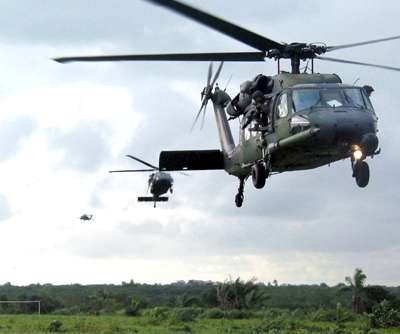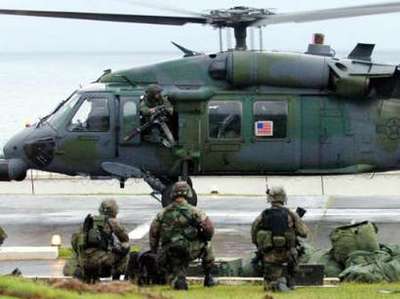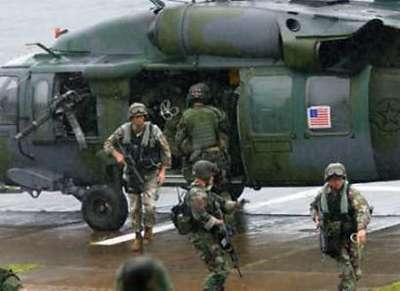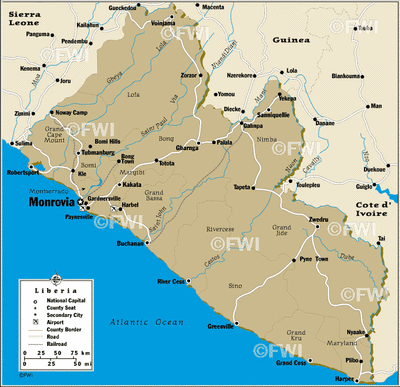Army Assisting In Embassy Evacuations
Three HH-60G Pave Hawk helicopters from the 56th Rescue Squadron
at Naval Air Station Keflavik, Iceland, carry evacuees from the
U.S. Embassy in Liberia on July 23. The squadron is deployed here
to provide personnel recovery and emergency evacuation for the
Humanitarian Assistance Survey Team in Liberia.
Flying 200 feet above palm trees and myriad grass huts, the 56th
Expeditionary Rescue Squadron completed its mission -- inserting
the remaining members of the Fleet Antiterrorism Security Team
and evacuating more people from the U.S. Embassy in Liberia.

The squadron, out of Iceland’s Naval Air Station Keflavik,
is part of the 398th Air Expeditionary Group. It has been in Sierra
Leone since July 13 providing personnel recovery and emergency
evacuation for the Humanitarian Assistance Survey Team in
Liberia.
“We are now an established air bridge here, providing a
lifeline for the embassy,” said Col. Steven Dreyer, 398th AEG
commander. “If anyone is in trouble, and we are called upon,
we can move in quickly and get them out.”
During the latest mission, the Air Force and the Marine Corps
worked hand in hand to get the 56th ERQS’s HH-60G Pave Hawk
helicopters loaded. The helicopters were soon packed with Marines
and their gear, and within minutes took off toward an undisclosed
staging area.

Security In The Midst Of Chaos
Upon arrival, a team from the 786th Expeditionary Security
Forces Squadron, also part of the 398th AEG, was dropped off to
secure the area and establish communications. Tech. Sgt. Robert
Arbelo, 1st Combat Communications Squadron, provided initial
communication between the helicopters and the command post.
"It was exhilarating being part of a mission like this,”
said Arbelo. It’s one thing to be a part of communications,
but it’s another thing to actually see what your
communications can accomplish. Usually you’re sitting behind
a radio away from the action. Here, you’re part of
it.”
Securing the forward-staging area with the rest of the security
forces team was Staff. Sgt. Ace Jones, 786th ESFS operations
superintendent.
“It’s not every day cops get to jump on a helicopter
and deploy forward to help the Marines,” he said. “So,
when a call comes for something like this, there’s no doubt,
they know you want to go, they just tell you to pack your
bags.”
Nearby, about 120 curious locals, mostly children, gathered
close to the scene. At that point, the area was secure and the
security forces team was awaiting the return of the helicopters
from the embassy with the evacuees. In the meantime, the local
children had fun talking to the airmen and having their pictures
taken with them.
Mohamed C. Kamara, Sierra Leone police constable, was among the
crowd.
“I’m not very happy about the fighting in
Monrovia,” he said. “I want it to end. It’s good
that the people are being evacuated because there have been too
many close hits on the embassy.”

Inbound.
Off in the distance, the faint sounds of the choppers were heard
and soon the first helicopter was visible. Children stood wide-eyed
as the three choppers flew around to the landing zone. The first
helicopter touched down as the wind from the blades parted the
grass beneath it. The other two set down and the evacuees jumped
off and ran to cover.
Along with the 18 evacuees, the rescue squadron flew five of its
people out of the embassy. They had been left there on the first
insertion of the FAST.
“The first time we took the FAST in, they wanted us to
stay at the embassy for medical support and to clear the landing
zone for their return,” said Senior Airman Mark Panzera, a
56th ERQS pararescueman. “The first night we were there, a
couple mortar rounds hit outside the embassy and injured a
reporter. The Marines let him in the embassy and we gave him
medical attention.”
Panzera said the fighting got worse outside the embassy and the
locals started piling bodies up at the front gates and shooting
rounds inside the embassy. “We were on standby in case any
mortar rounds hit and injured anyone. “It makes me feel
pretty good to be part of a mission like this,” said Panzera.
“It’s all just part of my job.”

One of the evacuees was Lt. Kristian Wahlgren, a Navy
contingency contracting officer with the HAST, who has been in
Liberia since July 6 helping assess the humanitarian assistance
situation. “Our first visit in Liberia was to the
clinic,” said Wahlgren. “There were people coming from
everywhere to greet us. It seemed like we brought so much hope. We
couldn’t move our vehicles because everyone was surrounding
us and cheering us on. They kept chanting, ‘We want peace, no
more war.”
Wahlgren said the team’s job was finished last week, but
when the random shelling started, they could not get out.
“This mission is a once-in-a-lifetime opportunity,”
said Maj. Brett Hartnett, the squadron’s combat rescue
liaison to the embassy. “You can read books, talk to people,
see things on TV, but never really get the experience of this
unless you live it. It’s a great feeling of satisfaction for
my pararescuemen and I to be able to pull out those
evacuees.”
 ANN's Daily Aero-Linx (05.06.25)
ANN's Daily Aero-Linx (05.06.25) ANN's Daily Aero-Term (05.06.25): Ultrahigh Frequency (UHF)
ANN's Daily Aero-Term (05.06.25): Ultrahigh Frequency (UHF) ANN FAQ: Q&A 101
ANN FAQ: Q&A 101 Classic Aero-TV: Virtual Reality Painting--PPG Leverages Technology for Training
Classic Aero-TV: Virtual Reality Painting--PPG Leverages Technology for Training Airborne 05.02.25: Joby Crewed Milestone, Diamond Club, Canadian Pilot Insurance
Airborne 05.02.25: Joby Crewed Milestone, Diamond Club, Canadian Pilot Insurance






